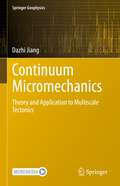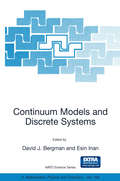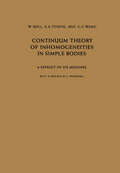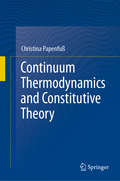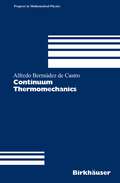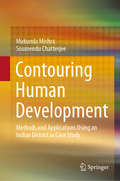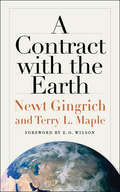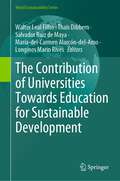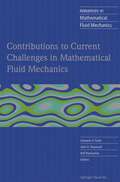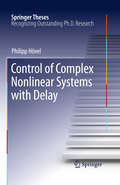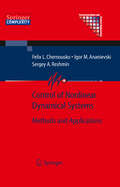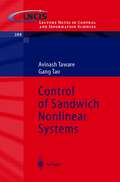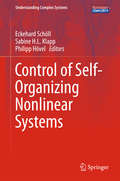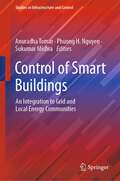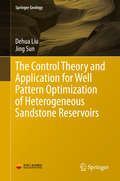- Table View
- List View
Continuum Micromechanics: Theory and Application to Multiscale Tectonics (Springer Geophysics)
by Dazhi JiangThe book integrates theory, numerical methods, and practical applications seamlessly. MATLAB and MathCad programs are provided for readers to master the theory, understand the approach, and to further develop and apply the methods to geological problems. Multiscale and multi-physics investigations of Earth and planetary processes have been an active trend of research in Earth Sciences, thanks to the development of scientific computation and computer software and hardware. Based on the author's research and teaching over the past 15 years, the book stands alone as the first comprehensive text in unifying fundamental continuum micromechanics theory, geometric/kinematic analysis, and applications. The book should appeal to a broad audience of students and researchers, particularly those in the fields of structural geology, tectonics, (natural and experimental) rock deformation, mineral physics and rheology, and numerical modeling of multiscale and coupling processes.
Continuum Models and Discrete Systems (NATO Science Series II: Mathematics, Physics and Chemistry #158)
by David J. Bergman Esin InanProceedings of the NATO ARW, Shoresh, Israel, from 30 June to 4 July 2003
Continuum Theory of Inhomogeneities in Simple Bodies: A Reprint of Six Memoirs
by W. Noll R. A. Toupin C. C. WangThe term "dislocation" is used in several different senses in the literature of mechanics. In the elassic work of VOLTERRA, WEINGARTEN, and SOMIGLIANA, it refers to particular solutions of the equations of linear elasticity, in which a con tinuous field of strain does not correspond, globally, to a continuous field of dis placement. The configuration of the body so obtained, even when that body is free of all load, is subject to interior stress that does not vanish, and in general no deformation of the body as a wh oIe can bring it into a stress-free configuration. Nevertheless, if any sufficiently sm all part of the body is considered by itself, a configuration for it in which the stress is everywhere zero may be found at once. In this work constitutiL"e assumptions provide the basic data. These consist in prescribed stress-free configurations for each material point and in prescribed elastic moduli governing the response to deformation from the stress-free configuration at each material point. Everything follows from these data, ineluding the dislocations present, if any. In particular, the common boundary-value problems of linear elasticity may be set and solved for the dislocated body.
Continuum Thermodynamics and Constitutive Theory
by Christina PapenfußThis book presents different thermodynamic approaches in the area of constitutive theory: thermodynamics of irreversible processes, rational thermodynamics, and extended thermodynamics. These different approaches are analyzed with respect to their presuppositions, as well as to their results, and each method is applied to several important examples. In many cases these examples are archetypes for numerous technologically important materials; i.e. complex materials having an internal structure. Some of the examples dealt with in this book are liquid crystals, colloid suspensions, ans fiber suspensions. The book well serves students and researchers who have basic knowledge in continuum mechanics and thermodynamics. It provides a systematic overview of the vast field of thermodynamic constitutive theory, beginning from a historical perspective and concluding with outstanding questions in recent research.
Continuum Thermomechanics (Progress in Mathematical Physics #43)
by Alfredo Bermúdez de CastroThe general goal of this book is to deduce rigorously, from the first principles, the partial differential equations governing the thermodynamic processes undergone by continuum media under forces and heat. Solids and fluids are considered in a unified framework. Reacting mixtures of fluids are also included for which general notions of thermodynamics are recalled, such as the Gibbs equilibrium theory. Linear approximate models are mathematically obtained by calculating the derivatives of the constitutive response functions. They include the classical models for linear vibrations of thermoelastic solids and also for wave propagation in fluids (dissipative and non-dissipative acoustics and internal gravity waves).
Contour Lines (large print)
by Adrian FarnsworthOn this page is a image of an area of land with contour lines (lines of equal height) marked on it. The land is shown as green and yellow in the middle of the page, and the contour lines are white.
Contour Map (tactile)
by RnibThis is a tactile diagram for GCSE level students. The diagram shows the line contours that indicate how steeply land rises - lines closer together indicate a steep slope, and lines further apart indicate a gentler slope, as shown with labels.
Contouring Human Development: Methods and Applications Using an Indian District as Case Study
by Mukunda Mishra Soumendu ChatterjeeThis book acquaints readers with a range of techniques to help them effectively identify, record, map, analyze and report on patterns in various dimensions of human development (HD) with spatial scales down to the village level. It is impossible to capture HD at the local and global scale with only a single index, because differences in HD at the international scale are caused by ‘general’ factors, whereas local-scale differences are influenced by ‘specific’ factors. This book offers a variety of methods for scientifically mapping HD at any spatial scale. It covers how to rationally select variables; how to test the models; how to validate the results, and how to analyze them. For this purpose, it employs a case study on an Indian district. The socio-economic factors regulating the patterns of HD are now more complex than they were only a few decades ago, making it essential to incorporate newer models in order to successfully ‘replicate’ the real-world situation. Accordingly, the book offers essential methodological tools & techniques for mapping HD. It sheds new light on a handful of statistical multivariate analysis and machine learning algorithms that are rarely used in the social sciences when dealing with HD, yet have sound mathematical and statistical bases. These techniques can be successfully used for predictive analysis in the earth & natural sciences, decision sciences and management disciplines, and are equally effective in terms of capturing, predicting and projecting the composite HD ‘landscape.’ This book will especially benefit two groups of readers: firstly, HD practitioners who want to find out ‘why some areas are doing better than others’ by exploring the complex interactions of spatially linked variables with different HD parameters. And secondly, practitioners in other branches of the social sciences who are not concerned with HD but are looking for ‘hands-on training’ with techniques they can apply in their respective field of spatial investigations.
A Contract with the Earth
by Newt Gingrich Terry L. MapleFocusing the environmental debate on the principle of common commitment, former Speaker of the House Newt Gingrich and eminent conservationist Terry L. Maple present A Contract with the Earth. They declare a need for bipartisan environmentalism—a new era of environmental stewardship with principles that they believe most Americans will share. While acknowledging that liberals and conservatives do not see eye to eye on many issues, Gingrich and Maple argue successfully that environmental stewardship is a mainstream value that transcends partisan politics. Their thoughtful approaches to our environmental challenges are based on three main premises: environmental leadership is integral to America's role in the world, technologically savvy environmental entrepreneurs can and should be the cornerstone of environmental solutions, and cooperation and incentives must be dramatically increased to achieve workable and broadly supported environmental solutions.Gingrich and Maple believe that most people—regardless of how they categorize themselves politically—are weary of the legal and political conflicts that prevent individuals and communities from realizing the benefits of environmental conservation. The foundation of the book—a ten-point Contract with the Earth—promotes ingenuity over rhetoric as the way forward.
A Contract with the Earth (PDF)
by Newt Gingrich Terry L. MapleFocusing the environmental debate on the principle of common commitment, former Speaker of the House Newt Gingrich and eminent conservationist Terry L. Maple present A Contract with the Earth. They declare a need for bipartisan environmentalism�a new era of environmental stewardship with principles that they believe most Americans will share. While acknowledging that liberals and conservatives do not see eye to eye on many issues, Gingrich and Maple argue successfully that environmental stewardship is a mainstream value that transcends partisan politics. Their thoughtful approaches to our environmental challenges are based on three main premises: environmental leadership is integral to America's role in the world, technologically savvy environmental entrepreneurs can and should be the cornerstone of environmental solutions, and cooperation and incentives must be dramatically increased to achieve workable and broadly supported environmental solutions.Gingrich and Maple believe that most people�regardless of how they categorize themselves politically�are weary of the legal and political conflicts that prevent individuals and communities from realizing the benefits of environmental conservation. The foundation of the book�a ten-point Contract with the Earth�promotes ingenuity over rhetoric as the way forward.
Contradictions of Neoliberal Planning: Cities, Policies, and Politics (GeoJournal Library #102)
by Tuna Tasan-Kok and Guy BaetenThis book argues that the concepts of ‘neoliberalism’ and ‘neoliberalisation,’ while in common use across the whole range of social sciences, have thus far been generally overlooked in planning theory and the analysis of planning practice. Offering insights from papers presented during a conference session at a meeting of the Association of American Geographers in Boston in 2008 and a number of commissioned chapters, this book fills this significant hiatus in the study of planning. What the case studies from Africa, Asia, North-America and Europe included in this volume have in common is that they all reveal the uneasy cohabitation of ‘planning’ – some kind of state intervention for the betterment of our built and natural environment – and ‘neoliberalism’ – a belief in the superiority of market mechanisms to organize land use and the inferiority of its opposite, state intervention. Planning, if anything, may be seen as being in direct contrast to neoliberalism, as something that should be rolled back or even annihilated through neoliberal practice. To combine ‘neoliberal’ and ‘planning’ in one phrase then seems awkward at best, and an outright oxymoron at worst. To admit to the very existence or epistemological possibility of ‘neoliberal planning’ may appear to be a total surrender of state planning to market superiority, or in other words, the simple acceptance that the management of buildings, transport infrastructure, parks, conservation areas etc. beyond the profit principle has reached its limits in the 21st century. Planning in this case would be reduced to a mere facilitator of ‘market forces’ in the city, be it gentle or authoritarian. Yet in spite of these contradictions and outright impossibilities, planners operate within, contribute to, resist or temper an increasingly neoliberal mode of producing spaces and places, or the revival of profit-driven changes in land use. It is this contradiction between the serving of private profit-seeking interests while actually seeking the public betterment of cities that this volume has sought to describe, explore, analyze and make sense of through a set of case studies covering a wide range of planning issues in various countries. This book lays bare just how spatial planning functions in an age of market triumphalism, how planners respond to the overruling profit principle in land allocation and what is left of non-profit driven developments.
The Contribution of Universities Towards Education for Sustainable Development (World Sustainability Series)
by Walter Leal Filho Thais Dibbern Salvador Ruiz de Maya María-del-Carmen Alarcón-del-Amo Longinos Marin RivesThe book gathers inputs from universities and research organizations working on matters related to sustainable development in a variety of contexts. It also provides a platform for the dissemination of information on the latest initiatives, paving the way for technology transfer and networking. Furthermore, the book intends to provide a fertile basis upon which universities may cooperate more closely in this key area. Universities, as centers of education, research, and innovation, have a unique position and responsibility in promoting sustainability. They can offer degree programs, courses, and workshops focused on sustainability, environmental studies, and related fields, educating students and the wider community about the principles and challenges of sustainability. Also, universities can conduct cutting-edge research to address sustainability challenges, such as climate change, resource depletion, and biodiversity loss. They can develop innovative technologies and solutions that promote sustainable practices in various sectors, including energy, agriculture, transportation, and urban planning. There is a perceived need to better understand and engage universities further on sustainability initiatives. Against this backdrop and in order to facilitate a broad discussion on the contribution of universities toward sustainability, this book is being produced.Last but not least, a further aim of the book is to present methodological approaches and experiences deriving from case studies and projects, which aim to show how sustainability may be incorporated as part of university programs.
Contributions of Chemical Engineering to Sustainability
by Juan Gabriel Segovia-Hernández Nelly Ramírez-Corona Valentina Aristizábal-MarulandaThis book discusses the recent advancements in chemical engineering and their role in achieving the United Nations' 2030 Agenda and Sustainable Development Goals (SDGs). Addressing these goals involves tackling intricate and interdisciplinary challenges.Chemical engineers have been diligently addressing a diverse array of issues across academia, society, and industry, with the aim of positively impacting these goals.The book offers essential insights and detailed analyses for each SDG. It explores the challenges encountered within various applications and proposes solutions based on foundational engineering principles. The book's content is tailored to professionals, students, and researchers across diverse fields, including engineering, environmental science, and biotechnology.
Contributions to Current Challenges in Mathematical Fluid Mechanics (Advances in Mathematical Fluid Mechanics)
by Giovanni P. Galdi John G. Heywood Rolf RannacherThis volume consists of five research articles, each dedicated to a significant topic in the mathematical theory of the Navier-Stokes equations, for compressible and incompressible fluids, and to related questions. All results given here are new and represent a noticeable contribution to the subject. One of the most famous predictions of the Kolmogorov theory of turbulence is the so-called Kolmogorov-obukhov five-thirds law. As is known, this law is heuristic and, to date, there is no rigorous justification. The article of A. Biryuk deals with the Cauchy problem for a multi-dimensional Burgers equation with periodic boundary conditions. Estimates in suitable norms for the corresponding solutions are derived for "large" Reynolds numbers, and their relation with the Kolmogorov-Obukhov law are discussed. Similar estimates are also obtained for the Navier-Stokes equation. In the late sixties J. L. Lions introduced a "perturbation" of the Navier Stokes equations in which he added in the linear momentum equation the hyper dissipative term (-Ll),Bu, f3 ~ 5/4, where Ll is the Laplace operator. This term is referred to as an "artificial" viscosity. Even though it is not physically moti vated, artificial viscosity has proved a useful device in numerical simulations of the Navier-Stokes equations at high Reynolds numbers. The paper of of D. Chae and J. Lee investigates the global well-posedness of a modification of the Navier Stokes equation similar to that introduced by Lions, but where now the original dissipative term -Llu is replaced by (-Ll)O:u, 0 S Ct < 5/4.
Contributions to International Conferences on Engineering Surveying: 8th INGEO International Conference on Engineering Surveying and 4th SIG Symposium on Engineering Geodesy (Springer Proceedings in Earth and Environmental Sciences)
by Alojz Kopáčik Peter Kyrinovič Ján Erdélyi Rinaldo Paar Ante MarendićThis book presents contributions from the joint event 8th INGEO International Conference on Engineering Surveying and 4th SIG Symposium on Engineering Geodesy, which was planned to be held in Dubrovnik, Croatia, on April 1–4, 2020 and was canceled due to COVID-19 pandemic situation. Editors, in cooperation with the Local Organisers, are decided to organize the Conference on-line at October 22-23, 2020. We would like to invite you to participation through http://ingeo-sig2020.hgd1952.hr/index.php/2020/08/31/ingeosig2020-virtual-conference-october-22-23-2020/. The event brought together professionals in the fields of civil engineering and engineering surveying to discuss new technologies, their applicability, and operability.
Contributions to Modern and Ancient Tidal Sedimentology: Proceedings of the Tidalites 2012 Conference (International Association Of Sedimentologists Series)
by Bernadette Tessier Jean-Yves ReynaudTidal deposits have been a specific research topic for about 40 years, and whilst this has resulted in a proliferation of papers in scientific journals, there have only been a few book-length syntheses. Over the years, tidal sedimentology has been reinforced by fluid mechanics and numerical modelling but has remained rooted in facies and stratigraphic studies. Recent developments in tidal sedimentology lean toward a more quantitative assessment of the imprint of tides in the facies record of intertidal and shallow subtidal areas. They highlight the increasing relevance of tidal deposits studies, from high resolution subsurface reservoir geology to climate change and sea-level rise. This volume gathers 17 contributions to the Tidalites 2012 congress held in Caen, France. It reflects current advances in the sedimentology and stratigraphy of tidal deposits, in both ancient and modern environments. It shows the current diversity of this field of research, through a wide spectrum of methods including remote sensing, in-situ hydrodynamical measurements, and ichnology, in addition to classic field studies and petrography.
Contributions to Modern and Ancient Tidal Sedimentology: Proceedings of the Tidalites 2012 Conference (International Association Of Sedimentologists Series)
by Bernadette Tessier Jean-Yves ReynaudTidal deposits have been a specific research topic for about 40 years, and whilst this has resulted in a proliferation of papers in scientific journals, there have only been a few book-length syntheses. Over the years, tidal sedimentology has been reinforced by fluid mechanics and numerical modelling but has remained rooted in facies and stratigraphic studies. Recent developments in tidal sedimentology lean toward a more quantitative assessment of the imprint of tides in the facies record of intertidal and shallow subtidal areas. They highlight the increasing relevance of tidal deposits studies, from high resolution subsurface reservoir geology to climate change and sea-level rise. This volume gathers 17 contributions to the Tidalites 2012 congress held in Caen, France. It reflects current advances in the sedimentology and stratigraphy of tidal deposits, in both ancient and modern environments. It shows the current diversity of this field of research, through a wide spectrum of methods including remote sensing, in-situ hydrodynamical measurements, and ichnology, in addition to classic field studies and petrography.
Control and Fate of Atmospheric Trace Metals (Nato Science Series C: #268)
by Jozef M. Pacyna Brynjulf OttarThe increasing production of industrial goods, heat, and energy, as well as traffic, has led to the release of considerable amounts of toxic trace metals to the atmosphere. The result is elevated concentrations of toxic metals in local populations and eco systems. Recently the problem of atmospheric long-range transport of trace metals has also been recognized. Significant amounts of these pollutants are disposed and deposited both on regional and global scales. In the atmosphere they may influence the chemical reactions. Of particular interest is their catalytic effect on the oxidation prosesses taking place in water droplets or on the surface of wet particles (e. g. the oxidation of sulphur dioxide to sulphate), however, the main environmental impact starts when the atmospheric trace metals are deposited on ground and vegetation and subsequently brought into the water circulation. During the later years significant progress has been made in the development of equipment to reduce and control the atmospheric emissions of toxic trace metals. This particularly applies to electrostatic precipitators and wet scrubbers for the collection of fine particles. The main objective of the workshop was to survey present knowledge concerning the sources, atmospheric fluxes, sinks and chemical impact of the atmospheric trace metals, and to review the developments of emission control equipment and the perspectives to reduce the potential risks from toxic metals. During the first two days of the meeting, 15 invited review papers were presented.
Control of Complex Nonlinear Systems with Delay (Springer Theses)
by Philipp HövelThis research addresses delay effects in nonlinear systems, which are ubiquitous in various fields of physics, chemistry, biology, engineering, and even in social and economic systems. They may arise as a result of processing times or due to the finite propagation speed of information between the constituents of a complex system. Time delay has two complementary, counterintuitive and almost contradictory facets. On the one hand, delay is able to induce instabilities, bifurcations of periodic and more complicated orbits, multi-stability and chaotic motion. On the other hand, it can suppress instabilities, stabilize unstable stationary or periodic states and may control complex chaotic dynamics. This thesis deals with both aspects, and presents novel fundamental results on the controllability of nonlinear dynamics by time-delayed feedback, as well as applications to lasers, hybrid-mechanical systems, and coupled neural systems.
Control of Magnetotransport in Quantum Billiards: Theory, Computation and Applications (Lecture Notes in Physics #927)
by Christian V. Morfonios Peter SchmelcherIn this book the coherent quantum transport of electrons through two-dimensional mesoscopic structures is explored in dependence of the interplay between the confining geometry and the impact of applied magnetic fields, aiming at conductance controllability.After a top-down, insightful presentation of the elements of mesoscopic devices and transport theory, a computational technique which treats multiterminal structures of arbitrary geometry and topology is developed. The method relies on the modular assembly of the electronic propagators of subsystems which are inter- or intra-connected providing large flexibility in system setups combined with high computational efficiency. Conductance control is first demonstrated for elongated quantum billiards and arrays thereof where a weak magnetic field tunes the current by phase modulation of interfering lead-coupled states geometrically separated from confined states. Soft-wall potentials are then employed for efficient and robust conductance switching by isolating energy persistent, collimated or magnetically deflected electron paths from Fano resonances. In a multiterminal configuration, the guiding and focusing property of curved boundary sections enables magnetically controlled directional transport with input electron waves flowing exclusively to selected outputs. Together with a comprehensive analysis of characteristic transport features and spatial distributions of scattering states, the results demonstrate the geometrically assisted design of magnetoconductance control elements in the linear response regime.
Control of Nonlinear Dynamical Systems: Methods and Applications (Communications and Control Engineering)
by Felix L. Chernous'ko I. M. Ananievski S. A. ReshminThis book is devoted to new methods of control for complex dynamical systems and deals with nonlinear control systems having several degrees of freedom, subjected to unknown disturbances, and containing uncertain parameters. Various constraints are imposed on control inputs and state variables or their combinations. The book contains an introduction to the theory of optimal control and the theory of stability of motion, and also a description of some known methods based on these theories. Major attention is given to new methods of control developed by the authors over the last 15 years. Mechanical and electromechanical systems described by nonlinear Lagrange’s equations are considered. General methods are proposed for an effective construction of the required control, often in an explicit form. The book contains various techniques including the decomposition of nonlinear control systems with many degrees of freedom, piecewise linear feedback control based on Lyapunov’s functions, methods which elaborate and extend the approaches of the conventional control theory, optimal control, differential games, and the theory of stability. The distinctive feature of the methods developed in the book is that the c- trols obtained satisfy the imposed constraints and steer the dynamical system to a prescribed terminal state in ?nite time. Explicit upper estimates for the time of the process are given. In all cases, the control algorithms and the estimates obtained are strictly proven.
Control of Sandwich Nonlinear Systems (Lecture Notes in Control and Information Sciences #288)
by Avinash Taware Gang TaoV VII X Table of Contents Table of Contents XI XII Table of Contents A. Taware and G. Tao: Control of Sandwich Nonlinear Systems, LNCIS 288, pp. 1-8, 2003. Springer-Verlag Berlin Heidelberg 2003 A. Taware and G. Tao: Control of Sandwich Nonlinear Systems, LNCIS 288, pp. 9-16, 2003. Springer-Verlag Berlin Heidelberg 2003 x(t), pilot valve piston position Return Pressure Source Return Load M, b y(t) A. Taware and G. Tao: Control of Sandwich Nonlinear Systems, LNCIS 288, pp. 17-28, 2003. Springer-Verlag Berlin Heidelberg 2003 load displacement, y(t) 3 2 1 0 ?1 ?2 ?3 0 10 20 30 40 50 60 70 80 90 100 solid?without DZ, dotted? with DZ Load displacement, y(t) 0.4 0.2 0 ?0.2 ?0.4 ?0.6 ?0.8 10 20 30 40 50 60 70 80 90 100 solid?without DZ, dotted?with DZ, dashdot?compensated Load displacement, y(t) 3 2 1 0 ?1 ?2 ?3 0 10 20 30 40 50 60 70 80 90 100 Control input, x(t) 0.8 0.6 0.4 0.2 0 ?0.2 ?0.4 ?0.6 0 10 20 30 40 50 60 70 80 90 100 solid?without DZ, dotted?with DZ, dashdot?compensated Load displacement, y(t) 0.6 0.4 0.2 0 ?0.2 ?0.4 ?0.6 ?0.8 0 10 20 30 40 50 60 70 80 90 100 solid?without DZ, dotted?with DZ, dashdot?compensated A. Taware and G. Tao: Control of Sandwich Nonlinear Systems, LNCIS 288, pp. 29-54, 2003. Springer-Verlag Berlin Heidelberg 2003
Control of Self-Organizing Nonlinear Systems (Understanding Complex Systems)
by Eckehard Schöll Sabine H. L. Klapp Philipp HövelThe book summarizes the state-of-the-art of research on control of self-organizing nonlinear systems with contributions from leading international experts in the field. The first focus concerns recent methodological developments including control of networks and of noisy and time-delayed systems. As a second focus, the book features emerging concepts of application including control of quantum systems, soft condensed matter, and biological systems. Special topics reflecting the active research in the field are the analysis and control of chimera states in classical networks and in quantum systems, the mathematical treatment of multiscale systems, the control of colloidal and quantum transport, the control of epidemics and of neural network dynamics.
Control of Smart Buildings: An Integration to Grid and Local Energy Communities (Studies in Infrastructure and Control)
by Anuradha Tomar Phuong H. Nguyen Sukumar MishraThis book provides an overview of how efficient building energy management can be done, considering the increasing importance of renewable energy integration. It also includes the grid-interactive building, their control, energy management, and optimization techniques to promote better understanding among researchers and business professionals in the utility sector and across industries. This book is written and edited by leading specialists active in concurrent developments in smart building management, renewable energy research, and application-driven R&D. The experiences and research work shared help the readers in enhancing their knowledge in the field of renewable energy, power engineering, building energy management, demand, and supply management and learn the technical analysis of the same in an insightful manner. Additionally, established and emerging applications related to applied areas like smart cities, the Internet of things, machine learning, artificial intelligence, etc., are developed and utilized to demonstrate recent innovations in smart building energy management.
The Control Theory and Application for Well Pattern Optimization of Heterogeneous Sandstone Reservoirs (Springer Geology)
by Dehua Liu Jing SunThe book is focused primarily on characteristics and determinative methods of reservoir orientation, the concept of vector well pattern and corresponding realistic techniques of well pattern deployment, well pattern control principles, Optimum design of well pattern based on the reservoir direction characteristics, and the schemes of well spacing density regulation at different stages of development. The procedures for improving water flooding efficiency have been provided. This book is suitable for reservoir engineering managers, reservoir engineers, and students of petroleum engineering.
